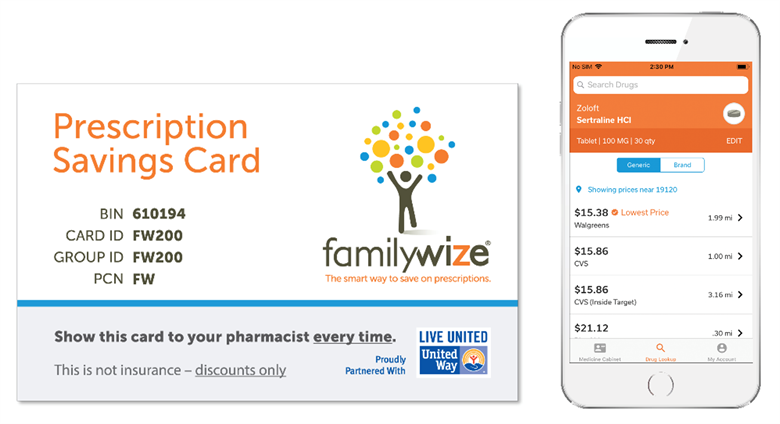FamilyWize Prescription Discount Card
United Way partners with FamilyWize to provide access to affordable prescription medications in order to ensure greater health and financial stability to community members.
The FamilyWize Prescription Savings Card:
- Is free for everyone – it’s like a coupon that you can use as often as you want.
- Reduces cost – just show the card every time to get the lowest prices, whether it be FamilyWize, insurance or retail price.
- Is easy to use with no registration or eligibility requirements.
- Covers FDA approved prescription medications.
- Saves an average of 45% on prescriptions.
- Accepted at major chain pharmacies nationwide.

How do I get a card?
- Download and print a card
- Text "family" to 700700 to receive a card on your phone (Message and data rates may apply. FamilyWize Terms and Privacy) Once you have received the card, you can opt out of getting messages by texting “STOP.”
- Download the FamilyWize app from the Apple App Store or Google Play.
Drug Price Lookup Tool
You are able to see the FamilyWize price of your prescription(s) by either going to familywize.org or by downloading the free FamilyWize app. Simply enter your drug name, dosage and zip code to find the lowest price within a 10 mile radius.
How it Works
FamilyWize negotiates fair drug prices directly with major pharmacies like CVS, Walmart, and Walgreens. We pass the savings onto our members, free of charge.
To start saving with FamilyWize, a member just needs to show the savings card to their local pharmacist whenever they fill a prescription at a participating pharmacy. The discount will be automatically applied to the retail price of the drug.
Members can use their card as often as they want. Cards do not expire. Cards may also be used for family members’ prescriptions and shared with friends.
Additional FAQs
Consult with your physician about alternative therapies
Before you begin a new prescription medication, talk with your doctor about non-prescription modifications to your lifestyle, diet or exercise. These changes may postpone, reduce or avoid the need for the cost of and taking a new medication.
Review your other medications
Disclose all the medications that you are taking to your physician and pharmacist before they prescribe or dispense a new medication. Some medications may intensify or reduce the effectiveness of another, or may even possibly duplicate the effects of another drug you are taking.
Select the lowest-cost alternative
Many brand-name prescription medications have a generic equivalent. Generic drugs are approved by the U.S. Food and Drug Administration for safety and effectiveness, and are manufactured under the same strict rules that apply to their brand-name twin. So ask your physician and pharmacist if there is a generic drug that will save you money. If no generic equivalent is available, there may still be a lower-cost alternative within the same class of drugs that performs the functions your care requires. Once again, consult with your physician on these money-saving alternatives.
Obtain a larger supply
In most instances, your cost per dosage will decrease as the amount you have dispensed at one time increases. If you will be taking a medication for an extended period of time, ask your physician if it would be appropriate to prescribe a 90-day supply rather than a 30-day supply.
Shop only at preferred pharmacies
All chain pharmacies and most independent pharmacies have been given equal opportunity to serve you via this program. Participating pharmacies are required to offer you deep discounts and assist in performing some fairly complicated drug management procedures for card holders, and not all pharmacies agree to participate. However, that gives you the confidence of knowing that pharmacies participating in this program are concerned with your health and saving you money, and therefore, are deserving of your business and loyalty.
Show your card every time
To ensure your medication is checked for safety and billed at the correct price, your pharmacist needs to transmit valuable information in your card. In some instances, the pharmacist may store your card information in their computer. However, to be certain you receive the maximum benefit, you need to show your card each time you have your prescriptions filled.
Understand your drug therapy
You invest a lot of money in medications. In order to get the most value for your dollar, you need to understand how to use your prescription drugs effectively. Make sure your physician and pharmacist explain how and when to take each prescription medication. Some factors to consider when trying to get the most from your medication are the effects of:
- Food and water being taken with your medication.
- The time of day you take your medication.
- Effects of other medications, including over-the-counter drugs, on your prescription.
Store your medications properly
Most medications will lose their effectiveness when they are subject to heat, moisture, light, or time. A steamy bathroom and a purse left in a hot car are examples of bad places to keep medicine. Store your medications in a cool, dark place. Remember to carry your daily or weekly medications in a pillbox to avoid damaging your entire supply of medication. Also, always remember to check expiration dates and check with your local hazardous waste coordinator to learn about the safest ways to dispose of expired medications.
Talk with your physician
Make sure that your physician knows that saving money is important to you. Ask that they prescribe a generic equivalent or lower-cost alternative if at all appropriate. Also, make sure that they know about any other drugs you are taking that may alter the effectiveness of the medication they are prescribing. Finally, make sure that you understand the drug therapy they prescribe so that you obtain the most value from the drugs that you are about to invest in.
